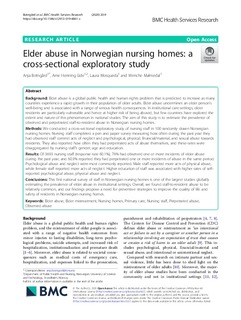| dc.contributor.author | Botngård, Anja | |
| dc.contributor.author | Eide, Arne Henning | |
| dc.contributor.author | Mosqueda, Laura | |
| dc.contributor.author | Malmedal, Wenche Karin | |
| dc.date.accessioned | 2020-01-27T14:19:30Z | |
| dc.date.available | 2020-01-27T14:19:30Z | |
| dc.date.created | 2020-01-06T10:00:39Z | |
| dc.date.issued | 2020 | |
| dc.identifier.issn | 1472-6963 | |
| dc.identifier.uri | http://hdl.handle.net/11250/2638144 | |
| dc.description.abstract | Background
Elder abuse is a global public health and human rights problem that is predicted to increase as many countries experience a rapid growth in their population of older adults. Elder abuse undermines an older person’s well-being and is associated with a range of serious health consequences. In institutional care settings, older residents are particularly vulnerable and hence at higher risk of being abused, but few countries have explored the extent and nature of this phenomenon in national studies. The aim of this study is to estimate the prevalence of observed and perpetrated staff-to-resident abuse in Norwegian nursing homes.
Methods
We conducted a cross-sectional exploratory study of nursing staff in 100 randomly drawn Norwegian nursing homes. Nursing staff completed a pen and paper survey measuring how often during the past year they had observed staff commit acts of neglect and psychological, physical, financial/material, and sexual abuse towards residents. They also reported how often they had perpetrated acts of abuse themselves, and these rates were disaggregated by nursing staff’s gender, age and education.
Results
Of 3693 nursing staff (response rate 60.1%), 76% had observed one or more incidents of elder abuse during the past year, and 60.3% reported they had perpetrated one or more incidents of abuse in the same period. Psychological abuse and neglect were most commonly reported. Male staff reported more acts of physical abuse, while female staff reported more acts of neglect. Higher education of staff was associated with higher rates of self-reported psychological abuse, physical abuse and neglect.
Conclusions
This first national survey of staff in Norwegian nursing homes is one of the largest studies globally estimating the prevalence of elder abuse in institutional settings. Overall, we found staff-to-resident abuse to be relatively common, and our findings propose a need for preventive strategies to improve the quality of life and safety of residents in Norwegian nursing homes. | nb_NO |
| dc.language.iso | eng | nb_NO |
| dc.publisher | BMC (part of Springer Nature) | nb_NO |
| dc.rights | Navngivelse 4.0 Internasjonal | * |
| dc.rights.uri | http://creativecommons.org/licenses/by/4.0/deed.no | * |
| dc.title | Elder abuse in Norwegian nursing homes: a cross-sectional exploratory study | nb_NO |
| dc.type | Journal article | nb_NO |
| dc.type | Peer reviewed | nb_NO |
| dc.description.version | publishedVersion | nb_NO |
| dc.source.journal | BMC Health Services Research | nb_NO |
| dc.identifier.doi | 10.1186/s12913-019-4861-z | |
| dc.identifier.cristin | 1766560 | |
| dc.description.localcode | © The Author(s). 2020 Open Access This article is distributed under the terms of the Creative Commons Attribution 4.0 International License (http://creativecommons.org/licenses/by/4.0/) | nb_NO |
| cristin.unitcode | 1920,1,0,0 | |
| cristin.unitcode | 194,65,20,0 | |
| cristin.unitname | Barne- og ungdomsklinikken | |
| cristin.unitname | Institutt for samfunnsmedisin og sykepleie | |
| cristin.ispublished | true | |
| cristin.fulltext | original | |
| cristin.qualitycode | 2 | |

